ITIL Knowledge Overview
ITIL uses a special vocabulary. Since we believe that correct terminology can be a big help towards mutual communication and understanding we would like to explain certain popular terms so that we can all share a common vocabulary. Dieter Gut, ITS Management, Quality and Process Management, elaborates on three important concepts. Perhaps for some of you this will provide a welcome brush-up.
- IT Service
- Release Management
- Change Management
From the explanations below we can clearly see how these three concepts are closely linked together.
IT Service
What is a Service? IT Service (definition): A means of delivering added value to customers by making it easier for customers or helping them to achieve their desired results without them having to personally bear the responsibility for specific costs and risks.
A service is not just a product. In the past IT was defined by products like hardware, software, PCs etc. Due to a higher dependency of the business on IT this view is not sufficient anymore. The business desires a partner who takes care of these products and offers a functioning IT as a service. IT service consists of several components: patterns and CIs. Release management takes care that all changes are implemented in accordance with other IT service management processes and aligned with business needs.
Figure 1: Service modules [Source: Fabio Consani]
Because each service generates production costs it also has a price. Since the price is negotiable (at ETH mostly zero), many service producers calculate according to internal production costs.
Examples of IT services: email, managed database, managed storage …
Release Management
This includes
- Service Releases
- Software Releases
- Hardware Releases
- Firmware Releases
The correlation between the above is determined by the service design.
Release Management encompasses the stream of activities of building/releasing changes. In other words, the central focus of release management is the planning and execution of the release. It is a structured blueprint to bundle up the rolling out of changes in effective manner. The phased roll-out also minimises incidents affecting users and necessitates less reactive intervention. Release Management is proactive planning on how new or modified services, which are basically introduction of changes, are rolled out. The release control follows the cycle of building, testing, preparing the package and its deployment execution. The crucial aspect of release management that distinguishes it from the Change Management process is the range of activities that emphasize on deployment of changes – how, when and at what rate.
Change Management – What is a Change?
Any change in IT service accomplished by some change request or change order. The ITIL defines it as any ‘addition, modification or removal of authorized, planned or supported service or service component and its associated documentation‘. One’s own product developments or projects also require change management. However the latter is only indirectly connected with what we are describing here. Once a change in a service or any of its components is planned, change management will be responsible for:
- providing a comprehensive plan taking into account interdependencies and timelines
- clearly defined responsibilities
- a risk assessment
- a test plan before, during and after change implementation
- a fallback plan with time limits
- release by the Change Advisory Board (CAB), unless it is a preplanned standard change
- making sure all stakeholders (customers, ITS staff) are informed before, during and after the change
- debriefing (PIR) for complex and sensitive changes
There are two basic types of change – regular change as outlined above and standard change. The latter is a recurrent procedure, which always proceeds according to the same workflows and with the same approvals. One example of a standard change is setting up a user account. The process is clearly defined, has already been tested hundreds of times and can therefore be executed quickly. This kind of change can often be completely automated.
For emergencies there is an express process called Emergency Change process. This allows quick and reliable implementation of security or time critical changes.
Posted on
in News English



